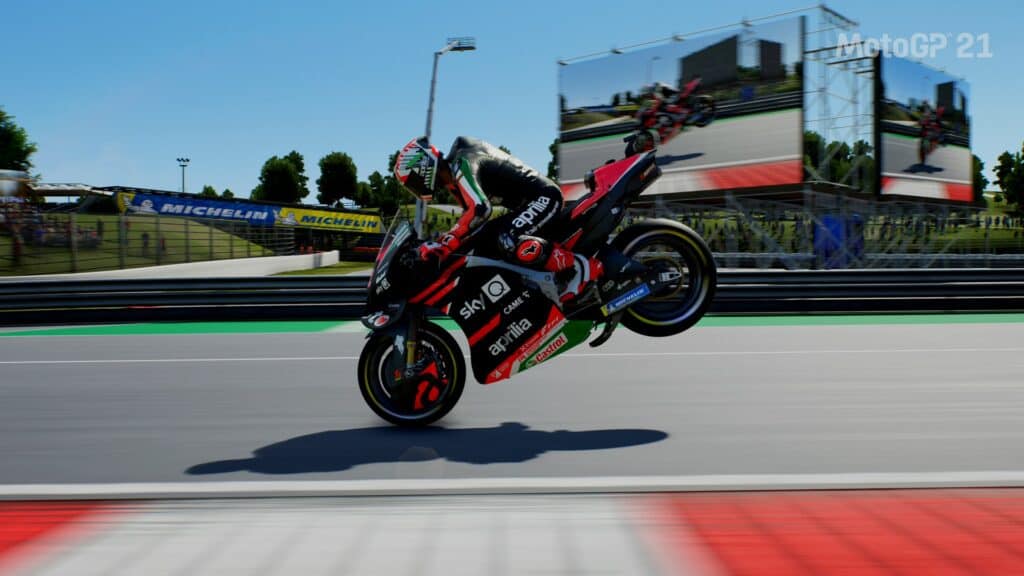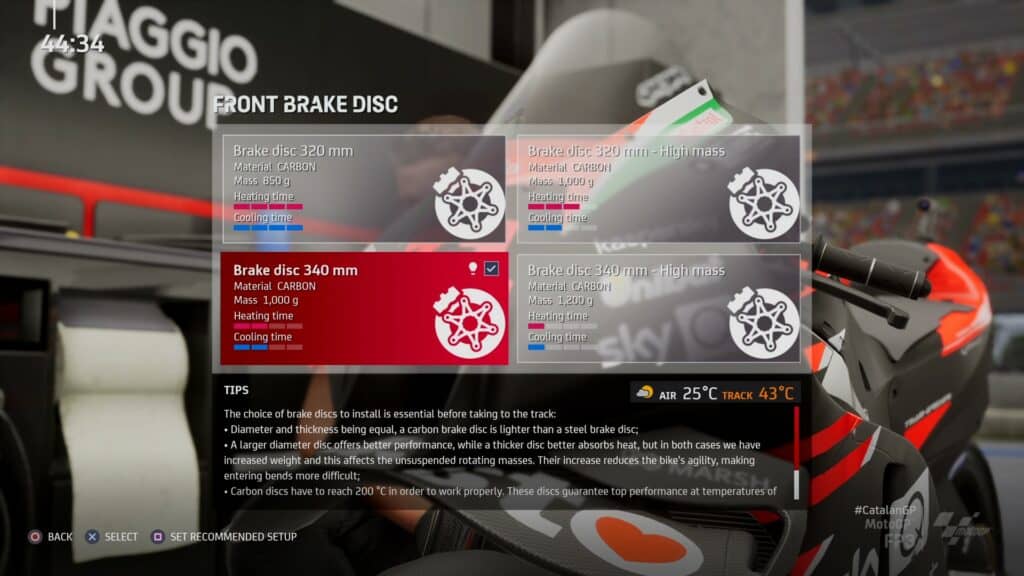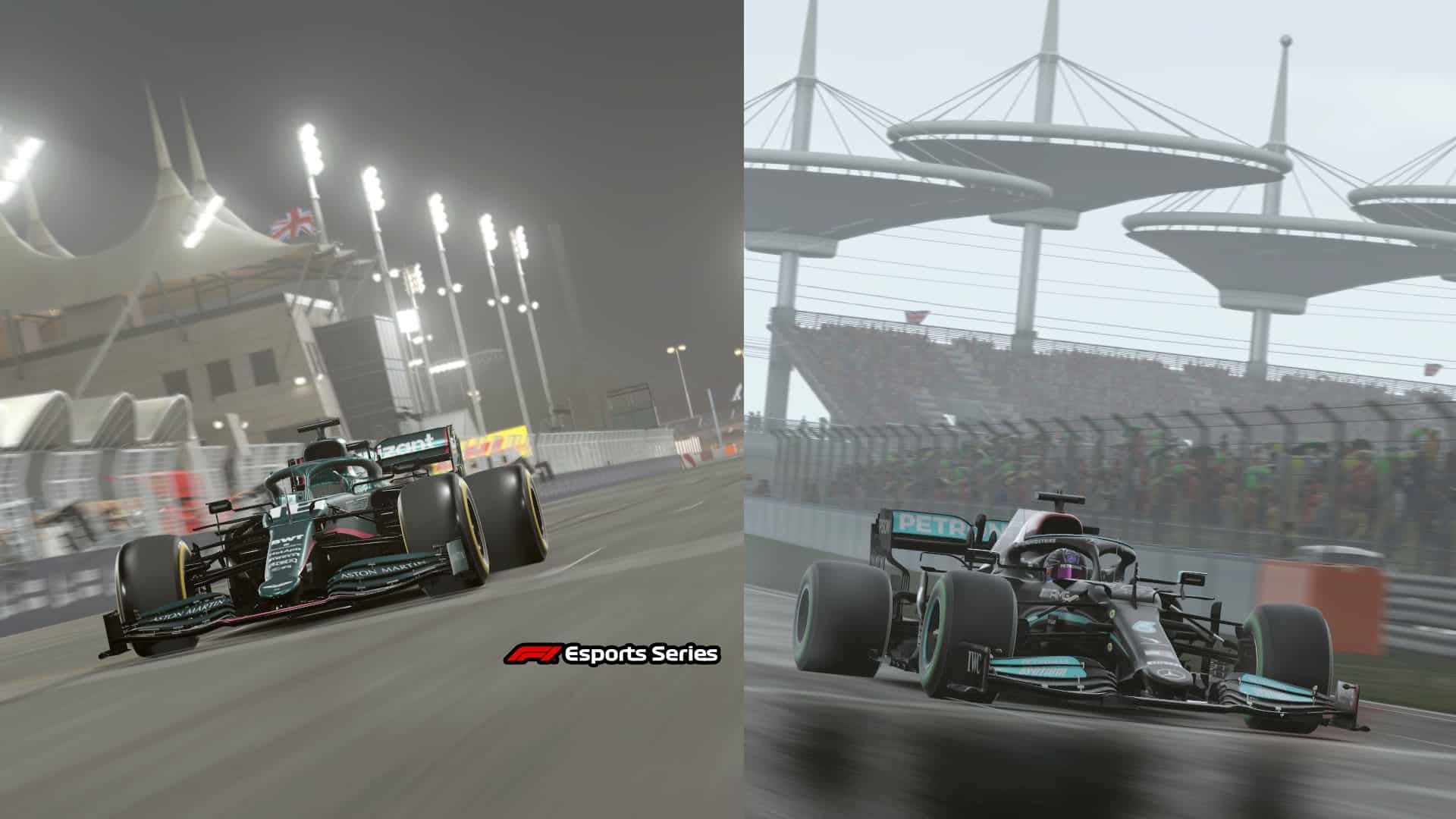The MotoGP game series is constantly changing up its physics from year to year to give a more authentic Grand Prix experience that is closer to simulation than it has ever been.
Whether you’re new to the series or an experienced player coming back with each iteration of the game, there’s one thing most players have difficulty with at some point and that’s braking.
It has changed over the years and developer Milestone has given more control to the player over getting the bikes stopped for corners. This however can cause problems with hard braking zones and more specifically the dreaded STOPPIE!
STOP(PIE) right there!
So, what exactly is a stoppie and why is it so bad?
A stoppie is caused by aggressively applying the front brake causing so much weight to transfer to the front of the bike; this, in turn, causes the weight at the rear of the bike to be transferred forward lifting the rear wheel into the air. Sure, it looks great and takes great skill to pull one off without throwing yourself over the handlebars completely, however in racing this can become your worst enemy because with your rear wheel up in the air you are now unable to lean into a corner.

In MotoGP 21 it is easy to pull a stoppie, so much so that you may get frustrated with how often you’re entering one when you’re seemingly not doing anything wrong. Fear not, I am here to help explain what you can do to prevent stoppies in the game and how to control them if needs be with a few techniques.
How may I assist?
If you’re new to the game don’t worry, Milestone has put assists in place to help you find your feet, these will help ensure you’re not going off track too often or crashing on the brakes. These assists are also customisable so you can gradually gain confidence with the brakes, let’s go through them.
Automatic Brakes
Braking is automatic, locally managed by the game based on reference speed. This means you won’t be braking too early or too late for the corners as the game does it all for you. The downside however is that it becomes very difficult to pass another rider as you will be braking at the same time if not a little before the AI. Great for beginners, but you’ll need to switch it off once you’ve acclimatised.

Assisted Front Brake
This will manage your brake pressure to ensure you don’t pull a stoppie or crash if you apply the brake during a corner, there are three options available for this, High, Moderate and Disabled.
High – This makes the bike more stable during braking, prevents stoppies and you can also use the front brake during maximum lean without risk of crashing.
Moderate – Stoppies and stabilities will need to be managed by the player, but the aid during braking will help prevent crashes due to error, to a certain extent…
Disabled – The player has complete control over braking and will have to manage bike stability, stoppies and also trail braking.

Brake Input Modulation
This modulates your braking to ensure you’re not being too aggressive and will help reduce the risk of stoppies, you can either have it enabled or disabled.
Enabled – Provides balanced braking, letting the player retain good control of the bike and reduces the risk of stoppies.
Disabled – Gives full control over braking, meaning the player can brake later and quicker but can run the risk of the front wheel locking and crashing.

Joint Brakes
Does exactly what it says on the tin. Using joint brakes means you don’t need to worry about using the rear brake manually, both front and rear brakes will be assigned to the left trigger (using default controls).
However, using the rear brake manually does have its benefits. For example, using it while accelerating hard out of a first gear hairpin will help keep the front of the bike on the ground, preventing a wheelie. Another good time to use the rear brake manually is at the Algarve International Circuit, Portimão. Between Turns 8 and 9 you will be faced with a hill, ascending one side before descending down the other. When you descend the hill the bike will naturally want to wheelie so again using the rear brake here will help keep the front wheel on the ground.
Using a high anti-wheelie setting will also help, but bear in mind this will slow you down as power is reduced to the rear wheel to keep the front on the ground.

Time to take off the training wheels
After a few hours of playing MotoGP 21 with the assists on, you may be getting comfortable and familiar with the game. It’s now time for a challenge – after all, the assists will only help you go so far in terms of pace, and in the long run, they will hold you back.
The quickest players have the assists turned off. It can be daunting at first, so start by turning the assists off gradually, get comfortable again and then turn more off. It will take time, patience and practice but once you complete your first flying lap with the assists off it will be very satisfying and worth the time.
Now it’s time for me to teach you how I personally slow down in MotoGP 21. I don’t use any assists and there’s a lot going on at once, so let me “brake” it down for you.
Choose the correct brake discs
This is very important as choosing the incorrect discs will result in your brakes either overheating or being too cold. Both will cause your brakes to be less effective and you will overshoot corners. If you’re unsure which brakes to use, look for the little lightbulb icon when selecting them, as it shows which are the best to use.

Learn your braking markers
This is very important. You may have noticed some horizontal white lines alongside the track on the approach to a corner, these are braking markers. Use these to learn where you should be braking. Some tracks even have distance in metres until the next corner.
However, you may find that some corners are missing braking markers If this is the case, try to find a static object on the approach to a corner at the side of the track and use this as a braking marker instead – providing you are stopping in time for the corner.
This takes practice, you may find yourself using the wrong braking marker to begin with and you’ll either overshoot the corner or slow down too much. But, once you learn which ones to use at each venue, it will become second nature.
Smoothly apply the brakes
The key to being quick on MotoGP 21 is to be smooth and this applies to braking as well. As mentioned earlier, being aggressive with the brakes by just slamming them on will cause you to pull a stoppie. So, to avoid this, be smooth with the application of the front brake.
Of course, you still need to be quick about applying the front brake but try to pull the left trigger smoothly rather and just banging it on in one swift motion.

Be as upright as possible
When deaccelerating, you want the bike to be as upright as you can as this will help you stop in time for the corners and give you much better stability on the brakes. Don’t have the motorcycle on a learn angle when entering a heavy braking zone deaccelerating – it will not end well.
Shift the riders weight
Pull back on the left analogue stick to shift your rider’s weight to the back on the seat, as this will help keep the rear of the bike on the ground and helps to prevent a stoppie. Simple.
Use the rear brake
I use the rear brake a lot, whereas some don’t use it at all. It all comes down to personal preference.
I find that it helps to get the bike stopped for corners in heavy braking zones and it can also improve stability. If, however, you are using a high engine braking setting, you may find the rear of the bike can lock up easier when using the rear brake. Therefore, I personally have engine braking set to the ‘2’ level.

Select the correct gear (if using manual selection)
Whilst doing all of the above you will also need to select the correct gear, so shift down the gearbox as you are slowing down. This is where engine braking will help in getting you stopped for the corners as well as the callipers, discs and pads.
Just bear in mind you don’t want to shift down the gearbox too rapidly as this can cause the bike to become unstable and cause the rear to lock up. Again, practice getting your timings right.
Know when to release the rear brake
Release the rear brake before entering a corner. With the default button layout, A for Xbox and Cross for PlayStation, you will find that the rear brake is effectively an on/off switch as you can’t control how much pressure is applied to the rear brake.
So, you will want to release the rear brake before entering a corner otherwise you may find the rear wheel sliding out of the ideal racing line and becoming difficult to control.
You can tame it, however, with a lot of practice and muse it to your advantage as “backing it in” gets the bike partially turned before you even enter the corner. Fair warning, this is a more advanced technique.

Ease off the front brake
As you tip into a corner you will want to ease off the front brake a bit, you will still want to have some brake pressure to get to the apex of the corner or “trail braking” as it’s more commonly known. You won’t always need to trail brake, it depends on how tight the corner is, your entrance line and your entrance speed. Hitting the apex is the key here, once you’re about to hit the apex or have hit the apex it’s time to release the front brake completely.
Apply the thottle upon corner exit
After you’ve hit the apex, it’s time to start accelerating again and exit the corner. Be careful with the throttle, especially after a tight corner, as you don’t want to crash at this point after all your hard work slowing down!
By doing all the above you will be able to brake confidently and efficiently without having to worry about pulling a stoppie.

One last thing
Turn 1 at the aforementioned Algarve International Circuit, Portimão, is horrible for stoppies. Not only is it at the end of the very long start/finish straight, so you will be going very fast, it’s also steeply downhill. This makes it even easier to pull a stoppie on the brakes even using the techniques above. Crashing without this guide is almost an inevitability here.
I find that braking a bit earlier than you’re supposed to helps a bit. If you find yourself in a stoppie, release the front brake a little bit to bring the rear of the bike back down and then increase the front brake again once the rear touching the ground.

That’s everything! As I said, I know there’s a lot going on in a short amount of time, but practising really does make a huge difference and I can’t stress that enough.
Once you put it all together, you will be braking without any problems and avoiding lifting the rear wheel unnecessarily. These are the techniques I personally use, and you may find that not all of them help your play style may be different, but experiment and you’ll find what works best for you.
In the meantime, keep it pinned and I’ll see you out on track!
ROBO46 is a motorcycle racing expert and has his own gaming YouTube channel. You can also listen to his motorcycle gaming opinions on an episode of The Traxion.GG Podcast.





















